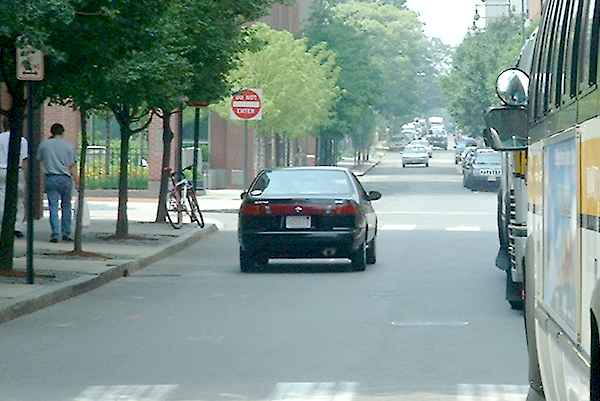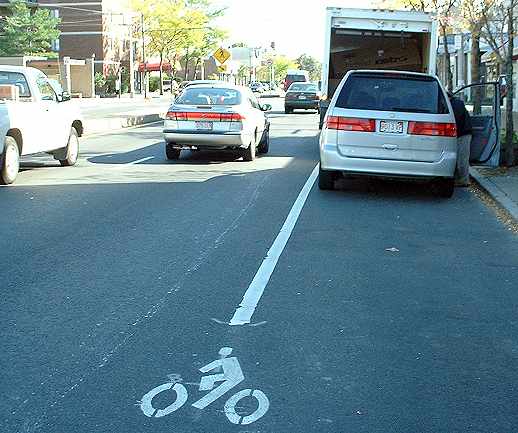
Top: Home Page
Up: Cambridge bicycle facilities and program
Previous:
Next:
CAMBRIDGE BICYCLE PROGRAMCambridge has relatively heavy bicycle use, thanks in large part to its compact size and to the large student population. In the early 1990's, Cambridge established a bicycle program, and since then has undertaken taken a variety of bicycling-related measures. I agree with many of the measures Cambridge has taken. I support the law enforcement and informational parts of the Cambridge bicycle program, and the installation of parking facilities. I also think that some traffic calming projects, and bottleneck-breakers like the Annis Crossing between Vassar Street and Cambridgeport, have begun to make more meaningful improvements for bicyclists and pedestrians, though I disagree with some details of these projects. But I have very mixed feelings about the Cambridge bike lane and trail installations. They reflect an ideological commitment to promotion of bicycling, without a corresponding level of common sense, engineering acumen, or respect for traffic theory and the results of research. As Rosalie Anders of the City of Cambridge acknowledged in May, 2000, bicycle use in Cambridge has not increased since the installation of bike lanes, and I don't find that surprising: there are many impediments to bicycling other than perceived road hazards, and most of the bike lanes don't really improve riding conditions. A major problem that Cambridge has not addressed is the use of conflicting one-way streets, which force bicyclists to go blocks out of their way, or else ride against traffic. Cambridge has actually been going backward on this issue. The Franklin Street-Green Street one-way pair runs parallel to heavily-traveled Massachusetts Avenue. In the late 1990s, the City changed the direction of travel on part of this pair so it can no longer be used in both directions. |
Conflicting one-way segments on Franklin Street

In the years 2001 and 2002, Cambridge has moved toward installations that are increasingly disturbing:
What is behind Cambridge's move toward such installations? Cambridge officials have stated that they "would like to experiment" with new treatments. Innovation and experimentation are generally a good thing. If I did not believe that, I would not be an engineer and inventor. However, repeated experimentation with designs that have already been shown to be unsafe and which defy national design standards is not a good thing. What other motives may Cambridge have? Increasing boldness in attempting to impose a Northern European vision of bicycle facilities? Frustration with the discovery that bicycle use has not increased? Or loss of communication between the Traffic Department and the Department of Public Works? Or what? The photo below is of a recent bike lane installation on Main Street.. The clear statement made by the bike lane stripe here is that bicyclists only turn right. Motorists may also turn right here, and so this installation encourages the "right hook" collision to an even greater degree than the Broadway/6th Street installation. |
Bike lane on Main Street at Fulkerson Street., Cambridge,
May, 2003

| The "bike line" is supposed to be an alternative to the bike lane. One was installed on Mt. Auburn Street west of Harvard Square in the 1990s, and it was far enough from parked vehicles to indicate a reasonable line of travel. But consider the one shown below, installed on Massachusetts Avenue north of Porter Square in the fall of 2003. |
Bike line in the taillight zone,
Massachusetts Avenue north of Cameron Avenue, October 20, 2003

Top: Home Page
Up: Cambridge bicycle facilities and program
Previous:
Next: